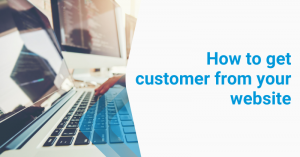
In this day and age, more and more companies opt for digital channels in order to find digital clients that will help them take their business to the next level.
The process known as lead generation is part of a strategy that is used to get more users and eventually turn them into clients. Of course, this doesn’t exactly answer the question “What is lead generation and how does any lead strategy work?”, but not to worry, we’ll get right into it in a bit.
The crucial thing to know is that lead generation marketing strategy is one of the key ingredients to a successful business. If you want to know what lead generation in digital marketing is, how you can put it to good use, and what the most common lead generation tools are – you need to keep reading because this blog is for you.
What is lead generation in digital marketing?
Lead generation is a type of process used to generate opportunities to sell products and services. This used to be a term that could be equally used for both offline and online media, but thanks to the digital revolution, it has gained even greater relevance.
That is pretty much what lead generation is in digital marketing – traditional lead generation strategies that have discovered a foothold in the online world.
How does it work?
Even though more than a few agencies specialize in the lead generation process – which should be easy to do in general – like all such things, it is very difficult to do right, especially when talking about lead generation in digital marketing.
So, what is the lead generation process?
Usually, the first step is to develop a website or partner up with other websites that will promote and advertise your product and/or service. These directories are supposed to be found by the consumer and then hopefully they complete an online request form.
The buyer’s information is then verified and matched to the appropriate providers – that is what we call a “lead”. These leads, that contain full contact information and purchasing requirements, are then sent to the prospectors and other people in charge of the sales process.
Which industries can benefit from using lead generation?
People often ask “What is lead generation in marketing?”. Even though lead generation marketing is mostly used in service-oriented industries, the truth is that this type of marketing can theoretically work for any type of business.
Insurance agencies, education institutions, real estate brokerages, office suppliers, furniture stores, etc. are among the most common types of businesses that use this method.
Local lead generation
There are two types of local lead generation – traditional and online – where the latter isn’t that much different from the former. Local lead generation entails focusing your marketing efforts on digital strategies that will attract the local community for your customer base.
Local business leads provide an abundance of data that can be harnessed in a way that helps your business reach new audiences that are likely to purchase your goods or your services.
Being that a lead is essentially an individual who has shown interest in your product or service, what local lead generation does is it sends prospects through a lead generation funnel with the intent to turn them into local business leads that are most likely to buy your product or service.
If you happen to be a local business, you should definitely invest into generating high-quality leads that will increase the chance of securing your future customers.
Benefits of lead generation
Lead generation is a powerful tool with numerous advantages for companies that want to get new clients and grow their business at the same time. Here we will list some of the greatest benefits of this tool.
Lead generation improves awareness
Simply put – the more people that are aware of your brand’s existence, the stronger your reputation and the larger your profit margin will be, which ultimately determines your brand’s overall value.
Brand awareness is a measure that indicates how well your brand is known within its target market, and lead conversion strategies are a way to inform people of your product and your values within that same market.
Increase of sales and profit
Recent statistics have shown that over 55% of marketers spend more than half of their budget on a lead strategy…
….and there is a good reason for that.
Having in mind that the main purpose of lead generation is to increase your sales, businesses that opt for a lead strategy are more likely to turn those same leads into actual customers, accounts, contacts or just opportunities. To put it in other words – if you want to endure in the market, lead conversion strategies are a must.
Target the customers you want
The lead generation method allows you to target your desired customers regardless of their demographic, thus determining your exact target audience in order to decide where you can make more sales.
Usually costs less than other types of advertisements
Every business requires advertisements in order to succeed, but every business should know up front what kind of advertisement works best for them. You need a marketing strategy that is both cost-effective and produces results.
And that is precisely what lead generation is in digital marketing – a great option for businesses that want to target a precise niche market and expand from there.
What is the most common lead strategy?
There are multiple lead generation marketing strategies out there and some of them can be very uncommon. However, there are a few that have earned a reputation as being very practical, which is why they are used most commonly.
This, of course, indicates that there is not one best lead generation strategy, but rather a few of them that work in tow.
1. Content marketing as a way to generate leads
Whether it comes as a recommendation or it pops up in social media, your content is the first thing your potential customer will see in relation to your brand. This is why you have to make an effort and create content that will showcase your expertise and forge a connection with your audience.
When planning your content as part of your lead generation strategy, you have to think about your sales cycle and who the content is made for, and then provide the right content at the right time.
For instance, you can:
- share user-generated images on social media in order to build awareness of your brand.
- publish detailed “how to” blogs for those who are not entirely sure they need your product and/or service yet.
- comprise detailed case studies and demos for those customers who are ready to buy from you.
2. Email marketing
Once you’ve managed to create high-quality content and showcased it to your consumers according to your sales cycle, you can start nurturing that relationship by using email marketing.
Email marketing as a lead generation strategy provides you with an opportunity to share the values of your brand directly with your audience.
As a tool, email marketing has proven extremely powerful. By constantly putting yourself out there, reminding your customers of your existence and helping them solve their problems, you will almost guarantee that you keep those customers for a long time. Here are some tips for effective email marketing:
- There are email marketing services you can sign up with to send out automated email sequences.
- Create an irresistible lead magnet that will inspire your website visitors to download it, in return for their subscription.
- Send emails that entertain, give value and that actually educate your subscribers.
- Along with nurturing emails, send the soft, promo ones as well, where you remind your subscribers where and how they can make a purchase.
3. Search Engine Optimization (SEO)
SEO is the ultimate lead generation tactic which allows you to tailor your content in a way that will lead the consumers directly to it, so they can subscribe and you can start nourishing your relationship.
The SEO lead generation strategy will increase your ranking in search engines for relevant keywords that relate to your business. When someone searches for those keywords, your website will be among the top results.
The rest is pretty clear – this potential consumer clicks on your website and gets completely enchanted by your high-quality content so they have no other option but to subscribe to get more of the same on a regular basis.
Voila! You’ve managed to convert a visitor into a subscriber, and from there, into a loyal customer.
Of course, these are far from the only steps you can undertake. There are many more lead generation tips and tricks out there. Smart wifi can be a lead capturing tool, for example, and one that has shown as pretty useful.
Lead generation tips for small businesses
When explaining what some of the most common lead generation tricks are, we’ve already established that content is king. The same applies when speaking about small business lead generation strategies.
Since there are many lead generation strategies out there, the first thing you have to do is choose a small business lead generation source that is going to best suit your needs. Aside from email marketing,, here are some of those strategies:
- Social media – a highly cost-effective way of generating interest when it comes to small business lead generation tools. There are more ways than you can count to present your content through various social media channels – blogs, infographics, videos, audios, e-books, images etc. Different methods work for different audiences, you just have to find the right one/s and stick to it/them.
- Free publicity – If you happen to have an interesting story that you deem as newsworthy and you know there is a publication that will be willing to publish it – PR is a way to go. This way you will showcase your product or service to a number of people within your target market. PR may not be a direct small business lead generation tool, but it certainly is a way to generate interest that will lead to sales.
- Advertising – This small business lead generation tool should be focusing entirely on your prospects’ interests in order to draw them in. Not only does it get your brand and your offer in front of a number of people within your target market, it also raises awareness and generates interest. You should always include an appealing call to action – to make a request for a paper brochure or sign up to your website.
- Telemarketing – This is a useful tool for following up other lead generation strategies. For instance, it is a great way to establish if you have the right contact/s within an organization, if you know what your customers want, and what they do and don’t like.
- Networking – Effective networking not only allows you to make new contacts, but also helps you build new relationships that will potentially give you access to their contacts and network.
After undertaking all the necessary steps and generating your leads, the only thing that is left is to carefully manage them.
This kind of effective management enables you to access your leads in terms of their demographics, tailor your marketing campaigns to them based upon these leads and behaviours, record the response of your leads to your campaigns, and recycle leads that aren’t yet ready for sale.
This blog sums up all the answers to the questions:
- What is lead generation in digital marketing?,
- How does it work?, and
- What tools are put to use?
However, the bottom line is, if you want to grow your business quickly using lead generation, you should know it comes at a price.
Since it can be a bit of a gamble, we advise you to choose your target market first and approach it like you would any other advertising venture. Lead generation is a great way to make additional profit and expand your business, but remember – always follow through and nurture the leads you’ve generated in order to close the sale.

















No comment yet, add your voice below!